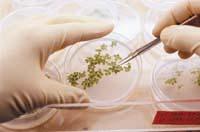Transgenics in laboratory and field
2009/04/18 Galarraga Aiestaran, Ana - Elhuyar Zientzia
Recently, scientists have taken another step on this path, creating totally new compounds by genetic modification of a plant. This step has been taken in the laboratories of MIT, from the herb of the incubator ( Vinca sp .). In fact, the countless herb itself produces a vinblastine used to treat Hodgkin lymphoma and other cancers, as well as other alkaloids of pharmaceutical interest. However, most are too toxic for human use.

Compared to GMOs grown in the fields, those growing to produce drugs are negligible.
(Photo: Syngenta)
To reduce toxicity or increase efficiency, MIT researchers have transformed the gene associated with a plant enzyme. This enzyme, which is involved in the production of alkaloids, has been the key for the plant to be able to produce completely new compounds. According to the researchers, laboratory tests are still being conducted, but the path they have opened is expected to serve to manufacture new medicines.
And some researchers working with a plant in the tobacco plant family also have high expectations. In fact, a group of researchers from the United States and Britain have transformed the venthamiana plant Nicotiana to make an anti-AIDS protein, which is currently having good results.
This protein is not new. It is called GRFT and consists of a algae. It is one of the most effective AIDS inhibitors and researchers believe it may be appropriate to practice icrobicides in order to protect it. The problem is that the production method usually used is very expensive, so it is inaccessible in many countries.
In order to reduce protein, researchers have already tried to produce from genetically modified plants, but in the tests carried out so far, these transgenic plants produced very few proteins. Insufficient.
Now they have tested with the plant N. benthamiana, on the one hand because it is easy to introduce the gene of the protein GRFT into the plant genome by means of viruses, and on the other, because it can grow in large densities in the greenhouse. Thus, researchers have obtained 60 grams of protein from a greenhouse of 460 square meters of surface. They say that with this amount you can make a million doses of microbicide.
From laboratory to fields
The first toxicity and efficiency tests have also been carried out, which seem to pose no problems. Therefore, they will continue research and hope to conduct clinical trials in the coming years. We'll see if they get the goal and how long it takes. In fact, although such tests are being conducted, no drugs obtained from transgenic plants have yet been published.
In fact, the main transgenic plants produced in the world are soy, corn and cotton. The first two are used to feed livestock and fuel cars, and cotton for the textile industry. About two-thirds of these transgenic plants are transformed for herbidic tolerance, and almost everything else to form an insecticide toxin. Example of this is Bt corn, the only one recognized in Europe. Thus, 70% of the world's soybeans last year and 24% of the corn was transgenic. Compared to them, they are insignificant those who grow in order to produce medicines.
Published in Gara

Gai honi buruzko eduki gehiago
Elhuyarrek garatutako teknologia





